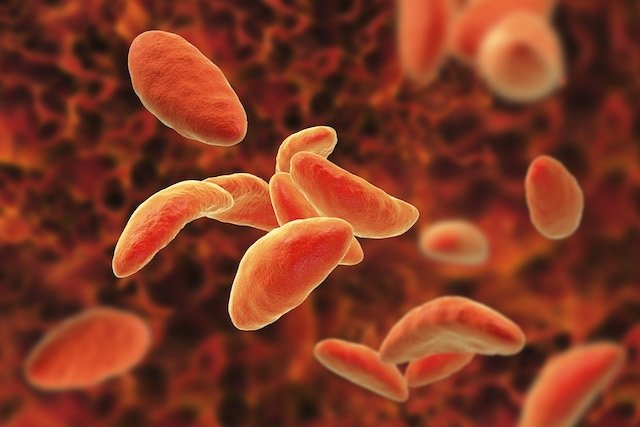Toxoplasmosis is a disease caused by the parasite Toxoplasma gondii which can be found in cat feces, water or undercooked meat such as pork or lamb, contaminated with the parasite. Most of the time, toxoplasmosis does not cause symptoms, however in the case of people with a more fragile immune system, it is possible to notice symptoms such as swelling, fever and muscle pain, for example.
Toxoplasmosis is transmitted mainly by ingesting food contaminated by the parasite’s cysts or through contact with the feces of infected cats. Furthermore, toxoplasmosis can be transmitted from mother to child, however this only happens when the disease is not diagnosed during pregnancy or treatment is not carried out correctly.
Although it does not cause symptoms, it is important that toxoplasmosis is identified and treated correctly according to the doctor’s instructions to prevent complications such as blindness, seizures and death, for example.

Main symptoms
The main causes of toxoplasmosis are:
- Lumps on the body, especially in the neck region;
- Fever;
- Muscle or joint pain;
- Tiredness;
- Headache and sore throat;
- Red spots on the body;
- Difficulty seeing.
In most cases, toxoplasmosis does not cause symptoms, however when the person’s immunity is more compromised, symptoms may appear. Thus, symptoms are more common in people who are undergoing chemotherapy for cancer, who have recently undergone transplants, are HIV positive, or in pregnant women.
In more serious cases, toxoplasmosis can harm the functioning of organs such as the lungs, heart, liver and brain, causing difficulty breathing, coughing, severe headache, dizziness, excessive tiredness, drowsiness, delirium and decreased strength and movement. of the body. Learn about other symptoms of toxoplasmosis.
How the diagnosis is made
The diagnosis of toxoplasmosis is made by a general practitioner or infectious disease specialist by evaluating the symptoms and carrying out a blood test to detect the presence of antibodies produced by the body against the parasite responsible for the disease. which are produced to combat the parasite that causes the disease. See more about the serological test for toxoplasmosis.
For pregnant women who test positive for toxoplasmosis antibodies, the obstetrician may recommend an amniocentesis after 15 weeks of pregnancy to confirm whether toxoplasmosis has been transmitted from mother to baby. Furthermore, although it is not used to diagnose toxoplasmosis in the fetus, the doctor must request an ultrasound to check if the baby has changes caused by toxoplasmosis, such as hydrocephalus, for example.
Transmission of toxoplasmosis
The main ways to get toxoplasmosis are:
- Ingestion of contaminated water;
- Consumption of raw, poorly sanitized or undercooked foods, such as pork, beef, lamb or venison, contaminated with T. gondii;
- Ingestion of smoked meat or sausages prepared from animals contaminated with the parasite and which have not been processed in accordance with adequate hygiene conditions;
- During pregnancy through the passage of the parasite through the placenta.
Contact with infected cats is not enough for toxoplasmosis to be transmitted, the person must have contact with the feces of these cats, which can occur through accidental ingestion of the parasite present in the feces. Therefore, when cleaning a cat’s litter box that has toxoplasmosis, it is important to take protective measures such as using gloves and masks, and washing your hands thoroughly after cleaning, for example.
Types of toxoplasmosis
O Toxoplasma gondii can be classified into some types according to the organ affected by the parasite, the main ones being:
1. Ocular toxoplasmosis
Ocular toxoplasmosis occurs when the parasite reaches the eye and affects the retina, causing inflammation that can lead to blindness if not treated in time. This disease can affect both eyes, and vision damage can be different for each eye, resulting in decreased vision, redness or pain in the eye.
This complication is more common in babies as a result of infection during pregnancy, especially if the fetus is infected at the beginning of pregnancy, but it also occurs in people with a more compromised immune system, although it is infrequent. See more about ocular toxoplasmosis.
2. Congenital toxoplasmosis
Toxoplasmosis during pregnancy causes congenital toxoplasmosis, which is when the baby is infected with this disease while still in the mother’s womb. Toxoplasmosis during pregnancy can lead to serious consequences, such as fetal malformations, low birth weight, premature birth, miscarriage or death of the baby at birth.
The consequences for the baby vary according to the gestational age at which the infection occurred, with a greater risk of complications when the infection occurs closer to the end of pregnancy, with a greater risk of inflammation in the eyes, intense jaundice, liver enlargement, anemia , cardiac changes, convulsions and respiratory changes. Furthermore, there may be neurological changes, mental retardation, deafness, micro or macrocephaly, for example.
3. Cerebrospinal or meningoencephalic toxoplasmosis
This type of toxoplasmosis is more common in people diagnosed with AIDS and is usually related to the reactivation of cysts. T. gondii in people who have a latent infection, that is, who were diagnosed and treated, but the parasite was not eliminated from the body, allowing it to travel to the nervous system.
The main symptoms of this type of toxoplasmosis are headache, fever, loss of muscle coordination, mental confusion, convulsions and excessive tiredness. If not identified and treated, the infection can lead to a coma and put life at risk.
How the treatment is carried out
Most healthy people do not need treatment for toxoplasmosis, as the body is capable of fighting the parasite naturally. However, in the presence of symptoms, treatment must be carried out with medicines that must be prescribed by the doctor, such as pyrimethamine, sulfadiazine and folic acid, used at the same time, in accordance with medical advice.
In pregnant women, depending on the stage of pregnancy, treatment can be carried out with the antibiotic spiramycin, or with pyrimethamine, sulfadiazine and folic acid, as advised by the obstetrician.
Understand how toxoplasmosis is treated.
Is toxoplasmosis curable?
Toxoplasmosis is curable and does not normally require specific treatment. However, it is important that the doctor is consulted, especially in the case of pregnant women and people with a weakened immune system, so that the best treatment can be indicated to combat the disease and achieve a cure.
Toxoplasmosis prevention
To prevent toxoplasmosis, it is important to take some precautions, such as:
- Consume drinking waterfiltered or mineral;
- Cook meat well and avoid consuming undercooked meat in restaurants;
- Wash kitchen utensils well in hot soapy water, such as cutting boards or knives, after seasoning or cutting raw meat, to avoid contaminating other foods;
- Wash fruits, vegetables and vegetables well with soap and water, or using a solution prepared with 1 liter of water and 1 tablespoon of baking soda or bleach, and leave for around 15 minutes;
- Wear gloves when gardening or take care of plants;
- Avoid contact with cat feces and wear a glove and mask when cleaning the litter box and collecting feces;
- Cover the sandbox in which the child playsto prevent cats from using the box to eliminate feces.
People who have pets should take them to the veterinarian for tests to identify the toxoplasmosis parasite and treat the animal, avoiding the possible transmission of toxoplasmosis and other diseases.

Sign up for our newsletter and stay up to date with exclusive news
that can transform your routine!
Warning: Undefined array key "title" in /home/storelat/public_html/wp-content/plugins/link-whisper-premium/templates/frontend/related-posts.php on line 12
Warning: Undefined array key "title_tag" in /home/storelat/public_html/wp-content/plugins/link-whisper-premium/templates/frontend/related-posts.php on line 13



